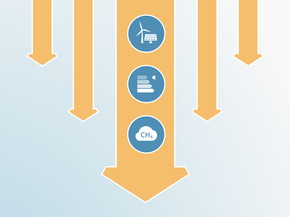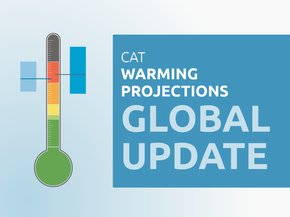Current Policy Projections
Economy-wide
According to our assessment, Mexico’s current policies will lead to emissions between 723 MtCO2e and 736 MtCO2e excl. LULUCF in 2020. In 2030, the emissions level is projected to reach 803–843 MtCO2e, excl. LULUCF. We estimated a range (see the Assumptions section for more details) as we consider it unrealistic that Mexico will achieve its target of 7% nuclear electricity generation in 2030 (lower end) and because it is uncertain which electricity source would be used to fill the gap. If instead of nuclear generation, gas combined cycle (gas CC) systems were used, Mexico would have higher emissions by 2030 (upper end). This scenario suggests that Mexico will neither meet its 2020 nor 2030 emissions targets and will need to implement additional policies to do so.
Historically, Mexico’s emissions have been increasing since 1990. GHG emissions have steadily shifted away from agriculture and LULUCF towards energy-related emissions. While in 1990 agricultural emissions represented 31% of Mexico’s GHG emissions, by 2015 their share had declined to 18%. Over the same time period, energy-related emissions increased substantially—by almost 40%.
The basis for climate policy in Mexico is its ‘General Climate Change Law’—which was adopted in 2012—translates the overarching targets into strategies and plans, and provides the institutional framework for implementation. The law does not include concrete political instruments, rendering it impossible to quantify its direct effects. Notably, the most recent reform to this law includes the addition of Mexico’s NDC sectoral emission reduction targets for transport, electricity generation, buildings, oil & gas, industry, agriculture and waste sectors.
The National Strategy on Climate Change (NSCC), published in June 2013, implements one of the requirements of the General Law. The NSCC is designed towards a long-term strategic development, but only provides very general guidance. How this will be translated into concrete action remains to be seen.
The 2nd Special Programme on Climate Change (PECC 2014–2018), published in 2014, includes the most relevant mitigation measures to 2018. The programme summarises 23 quantified mitigation-relevant measures that lead to a reduction in emissions by 83 MtCO2e in 2018 compared to the baseline presented in the same document. Mexico’s General Climate Change Law establishes that a new PECC will be developed with every incoming administration (Cámara de Diputados del H. Congreso de la Unión. Diario Oficial de la Federación, 2012). This means that Mexico’s new president—Andrés Manuel López Obrador—and his team are responsible for the development of the PECC 2018–2022.
López Obrador´s campaign did not have a clear position on climate change, focusing instead on the energy sector. Here, he stressed the need to achieve energy security to replace oil and gas imports from the United States. To achieve this, the president proposed sectoral changes that include fostering national extraction of oil & gas, building new refineries, remodelling old refineries and increasing electricity production. To increase electricity production, he proposes three actions: 1. increase the load factor of hydro power plants, 2. avoid the planned retirement of thermal—fossil fuel—power plants (by converting old ones to cogeneration and all units over 150 MW to gas CC) and 3. create programmes to foster energy transition to RE—solar PV, wind and hydro. Depending on whether and how these campaign promises will develop into actions, it remains to be seen what the impacts on climate change will be.
In 2014, Mexico implemented a carbon tax that is set at approximately at US$3.5/tCO2e differentiated by fuel type (SEMARNAT, 2014). This tax is expected to generate an annual revenue of about US$1 billion. However, its impact on GHG emission reduction is unclear and, given its low rate, a substantial emission reduction is unlikely. At the end of 2017, the regulation for the use of emission reduction credits for compliance under the carbon tax in Mexico came into force. This regulation establishes the allowance of Certified Emissions Reductions (CERs)—from CDM projects in Mexico—as well as Green Certified Emission Reductions—in the EU ETS—as payment means under the carbon tax (Diario Oficial de la Federación, 2017; World Bank Group and Ecofys, 2018).
In 2017, Mexico began a simulation of a voluntary Emissions Trading Scheme (ETS). The General Climate Change Law was amended later that year to make the scheme mandatory as soon as its three-year pilot phase concludes. The ETS will not replace the existing carbon tax. The ETS’ pilot phase—originally programmed to start in August 2018—will begin operation in 2019 (Secretaría de Medio Ambiente y Recursos Naturales (SEMARNAT), 2017, 2018).
A further reform to the LGCC in 2018 lays the foundation for the establishment of the mandatory carbon market by putting in place mechanisms for cost-efficiency, MRV, deadlines and obligations following the pilot-phase (Congreso General de los Estados Unidos Mexicanos. Diario Oficial de la Federación, 2018).
The formal start of the ETS—originally planned for August 2021, together with the entry into force of the Paris Agreement—has been delayed to 2022 (Secretaría de Medio Ambiente y Recursos Naturales (SEMARNAT), 2017, 2018). Between 400 and 700 companies are expected to participate in the market (Santiago and Rodríguez, 2017).(Secretaría de Medio Ambiente y Recursos Naturales (SEMARNAT), 2017, 2018).
A further reform of the LGCC in 2018 lays the foundation for the establishment of the mandatory carbon market by putting in place mechanisms for cost-efficiency, MRV, deadlines and obligations following the pilot-phase. The formal start of the ETS—planned for August 2021, together with the entry into force of the Paris Agreement—is estimated for 2022. Between 400 and 700 companies are expected to participate in the market.
Energy supply
In its NDC, Mexico committed itself to unconditionally reduce GHG emissions from electricity generation and oil & gas by 31% and 14% respectively in 2030 from a business as usual base line (Government of Mexico, 2015). These commitments have been added to the General Climate Change Law in its July 2018 reform.
The Energy Transition Law (Cámara de Diputados del H. Congreso de la Unión. Diario Oficial de la Federación, 2015), published in December 2015, includes clean energy targets for Mexico for the year 2018 (25% of generation), 2021 (30%) and 2024 (35%). Clean energy according to Mexican law includes renewable energy sources, nuclear power, CCS as well as efficient cogeneration (Congreso General de los Estados Unidos Mexicanos. Diario Oficial de la Federación, 2014).
The inclusion of the latter technology is particularly noteworthy as cogeneration plants are mostly gas based and thus emit CO2. While this technology currently does not play a role in Mexico, the latest Energy Outlook—Prospectiva del Sector Eléctrico 2017 -2031—published by the Mexican government (SENER, 2017b) suggests that the share of cogeneration might grow to 5% of total generation in 2030. This implies that the share of zero-emission power plants might be lower than what the Clean Energy Target indicates. For instance, for 2024 the projections foresee a share of 5% of cogeneration in the electricity mix, potentially lowering the share of zero-emission power generation under the 2024 clean energy target to 32%, a gap of 3%.
In the same electricity projections, 590 MW of coal-fired capacity is added between 2018 and 2020. The projections suggest that coal-fired generation will peak in 2024, and will be reduced by 16% between 2025 and 2030 (SENER, 2016). The share of coal-fired electricity generation is higher than previously projected (SENER, 2016). In comparison the coal electricity generation share in 2030 was almost negligible (1%), the latest projection suggests a share of 8%. This is a reversal of the government’s previous plan to steadily reduce the amount of coal-based electricity from 2017, and it is inconsistent with the steps needed to achieve the Paris Agreement's 1.5°C limit For the power sector this would mean Mexico should build no new coal plants, and emissions from the existing coal fleet should be reduced globally by two-thirds over 2020-2030 and to zero by 2050 (IPCC, 2018).
The current Energy Outlook also projects lower nuclear generation by 2030 than previous versions. Due to the changes in coal and nuclear projections, the updated emissions are larger than previous CAT estimates. Nevertheless, the Energy Outlook states that nuclear electricity generation will still grow to make up 7% of generation in 2030 (compared to 3.6% in 2016). According to Mexico’s Energy Secretary, building this additional nuclear capacity would require several billion dollars of investment, and the federal government will need to make this decision after 2018 (Valencia Juliao, 2017). Past editions of the Energy Outlook have also considered nuclear in later years, however no concrete scheduling plans of budget allocation have been decided by the government. After the energy reform, the state maintained the right to control and develop nuclear energy. We question whether nuclear will be developed as expected in the Energy Outlook given the lack of long-term planned funding (Valencia Juliao, 2017). Worldwide, lead-time and financial costs of nuclear power have increased in the last 35 years (J.Portugal-Pereira et al., 2018).
There is currently only one nuclear plant operating in Mexico, the Central Nucleoeléctrica Laguna Verde. The plant was constructed to house five reactors, but only two are operating. The Mexican government has commissioned preparatory technical studies to install two further reactors, which could be built at the Laguna Verde plant. However, the Sub-secretary of Energy indicated that each additional reactor would require over a billion dollars of investment, and that the federal government will need to make the investment decision (Valencia Juliao, 2017). The Laguna Verde project, which was envisioned as the first part of a larger nuclear project, ran significantly over schedule and budget (Rother, 1987; Williams, 1987; Miramontes, 1989). Should Mexico choose not to invest in additional nuclear capacity, but rather increase generation from gas-based cogeneration, its emissions in 2030 would be 8 MtCO2 higher.
Mexico intends to use a combination of clean energy certificates (Secretaria de Energia, 2014), measures to support clean distributed generation, and a tender scheme to help reach its clean energy target. If a plant uses clean energy and fossil fuel sources, a clean energy certificate (CEL) will be granted for each MWh generated from clean energy. The clean energy certificate scheme will include targets for both electricity suppliers and large consumers (those with a load larger than 1 MW), and the tender scheme aims to procure new capacity in a competitive manner.
Preliminary results are promising, showing that tenders might be especially effective in increasing the share of renewables, especially solar and wind, as a large number of projects were awarded, with record low prices (SENER, 2016; Centro Nacional de Control de Energía, 2017). However, the status of the projects resulting from these three tender rounds of electricity auctions is not clear. Currently, there is no overview by the government and information on single projects is only mentioned in news reports.
In December 2017, Mexico’s Secretariat of Energy announced that the Villanueva 3 solar PV park of Enel Green Power Mexico had started commercial operations, becoming the first winning project from the country’s first long-term power auction to feed power into the national electricity system (SENER, 2017a). Villanueva 3 will gradually reach a capacity of 250 MW. According to the media, El Cortijo wind farm was the first project from the first tender round to begin construction in 2017. This project is expected to start operations in the second half of 2018 (ACCIONA, 2017).
In June 2017, the Asociación Mexicana de Energía Solar (Asolmex), which was awarded 28 solar projects in the first and second tenders, commented that 35% of the capacity awarded in these rounds was in the late stages of development or under construction (El Norte, 2017).
The status of construction and expected operation start dates of other projects are less clear. Since these projects have roughly two years to be built after the auction, it is too early to say how many will be commissioned on time. According to the tender regulations, the start date of operation for awarded projects is flexible and can be modified free of penalties under certain circumstances (e.g. if the delay can be attributed to governmental authorities or if specified in the contact) (SENER, 2015a). Penalties for missing the start of the operation date include monthly payments of 5% of offered cost, plus an increase of 10% warranty for up to two years.
Our bottom-up calculations on the awarded projects from the first three long-term electricity auctions indicate that if all tendered projects get to operation—at least four years after their respective tendered year—Mexico would reach 33% renewable electricity generation in 2030. If Mexico continues to have annual tenders until 2030 in the same manner that they been happening—and assuming all these projects get built and operate—Mexico will still need efficient cogeneration and nuclear power to achieve its 2021 and 2024 clean energy targets.
Nevertheless, it remains unclear whether all awarded projects will be realised and if tenders will continue to happen in the future. Similar tender processes in other countries have shown that the award in a tender process does not necessarily lead to the fully timely project realisation.
Forestry
In its NDC, Mexico committed itself to unconditionally reduce GHG emissions from the forestry sector by 144% in 2030 from a BAU baseline (Government of Mexico, 2015). Unlike the commitments on other sectors this commitment was not included in the July 2018 reform to the General Climate Change Law (Government of Mexico, 2015).
Mexico’s REDD+ National Strategy 2017-2030 (ENAREDD+) established strategic action lines with the aim of promoting continued reduction of LULUCF emissions and achieving 0% net deforestation rate by 2030 (CONAFOR, 2017).
Waste
In its NDC, Mexico committed itself to unconditionally reduce GHG emissions from the waste sector by 28% in 2030 from a BAU baseline (Government of Mexico, 2015). This commitment has been added to the General Climate Change Law in its July 2018 reform (Government of Mexico, 2015).
GHG emissions from the waste sector have increased by more than 70% between 1990 and 2015 according to the most recent inventory data, making this sector with the highest emissions increase in this period.
Further analysis
Latest publications
Stay informed
Subscribe to our newsletter




